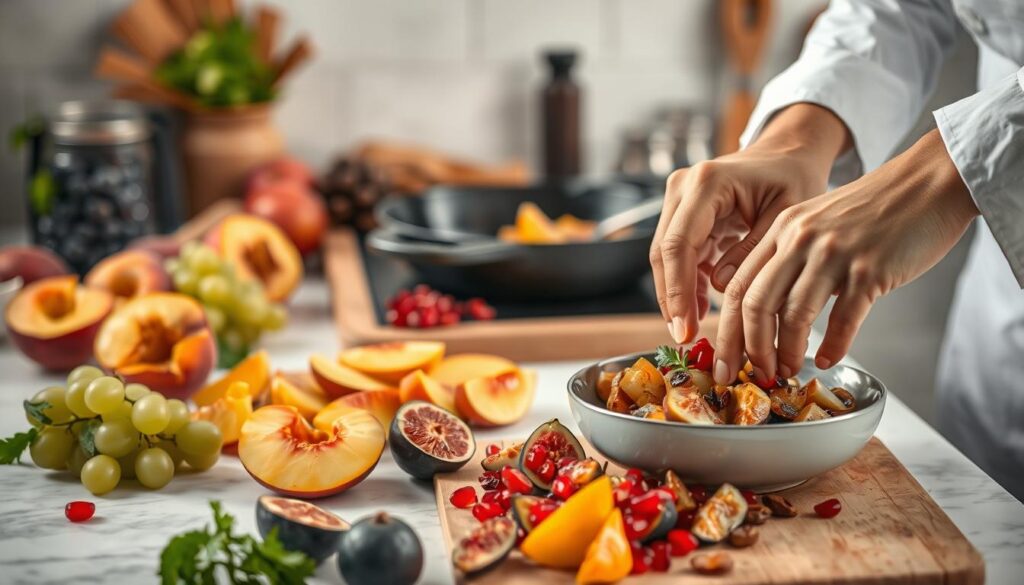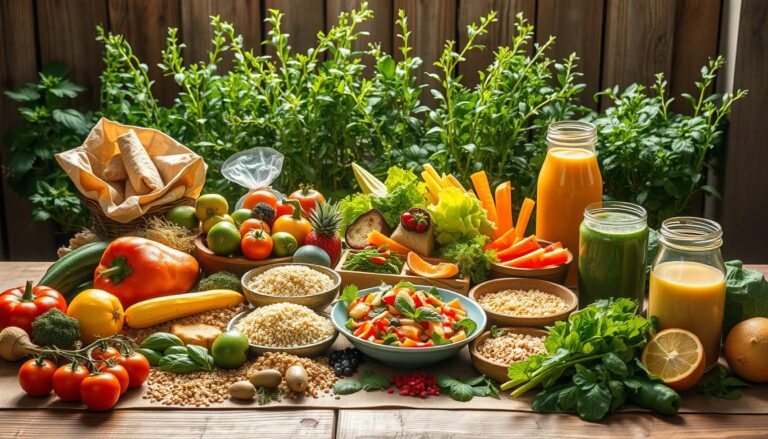Discover Savory Fruit-Based Dishes for Unique Meals
Exploring the world of savory fruit-based dishes can elevate your meals and unlock new culinary creativity. By understanding the balance between sweet and savory flavors, you can create unique meals that will impress your family and friends.
The fusion of fruits into savory cooking is a culinary revolution that’s gaining momentum worldwide. It’s not just about adding fruits to your meals; it’s about creating a harmonious balance of flavors that will leave you wanting more.
Key Takeaways
- Discover how to balance sweet and savory flavors in your cooking.
- Explore various cuisines that incorporate fruits into savory dishes.
- Learn new recipes and techniques to enhance your culinary skills.
- Understand the science behind combining fruits and savory ingredients.
- Get inspired to create unique meals with fruits as a staple ingredient.
The Culinary Revolution: Fruits Beyond Dessert
Fruits are revolutionizing the way we think about savory meals, moving beyond their traditional role in desserts. This shift is part of a broader culinary revolution where chefs and home cooks are experimenting with fruits in savory applications, creating unique and exciting flavor profiles.
Why Fruits Work in Savory Applications
Fruits bring a natural sweetness and acidity that can enhance and balance savory flavors. The versatility of fruits allows them to be used in various forms – fresh, dried, pickled, or cooked – making them suitable for a wide range of savory dishes. For instance, the sweetness of caramelized peaches can complement the smokiness of grilled meats, while the tanginess of pomegranate seeds can add depth to salads.
| Fruit | Savory Application | Flavor Profile |
|---|---|---|
| Peaches | Grilled Meats | Sweet and Smoky |
| Pomegranate | Salads | Tangy and Fresh |
| Apples | Pork Chops | Crispy and Sweet |
The Science of Sweet-Savory Balance
Achieving a perfect sweet-savory balance is crucial when incorporating fruits into savory dishes. This balance is rooted in the science of flavor pairing, where the natural sugars in fruits can counterbalance salty, umami, or spicy flavors. Understanding this chemistry allows cooks to create harmonious and complex flavor profiles. For example, pairing mango with spicy chilies can create a delightful contrast of flavors.
10 Most Versatile Fruits for Savory Cooking
When it comes to savory cooking, not all fruits are created equal, but some stand out for their versatility. Certain fruits can elevate a dish from ordinary to extraordinary, adding unique flavors and textures that complement a wide range of ingredients. In this section, we’ll explore the top 10 fruits that are perfect for savory cooking, categorized into three main groups.
Stone Fruits: Peaches, Plums, and Apricots
Stone fruits like peaches, plums, and apricots are incredibly versatile in savory cooking. They can be grilled, roasted, or sautéed and added to salads, stews, or as a topping for meats. For instance, grilled peaches can add a sweet and smoky flavor to a summer salad, while plums can provide a tangy contrast to rich meats like pork.
Tropical Varieties: Pineapple, Mango, and Papaya
Tropical fruits such as pineapple, mango, and papaya bring a burst of flavor to savory dishes. Pineapple can be used in salsas or as a topping for grilled meats, while mango can add a creamy texture to curries. Papaya, with its slightly musky flavor, can be used in salads or as a marinade for chicken or fish.
Everyday Fruits Reimagined: Apples, Pears, and Berries
Even everyday fruits like apples, pears, and berries can be reimagined in savory cooking. Apples can add a crisp texture to salads or be used in savory tarts, while pears can be poached and served with cheese or meats. Berries, especially cranberries and cherries, can add a tart flavor to sauces and braising liquids.
| Fruit | Savory Dish | Flavor Profile |
|---|---|---|
| Peaches | Grilled Peach Salad | Sweet, Smoky |
| Pineapple | Pineapple Salsa | Tangy, Tropical |
| Apples | Savory Apple Tart | Crisp, Earthy |
Exploring Savory Fruit-Based Dishes Around the World
As we explore global cuisine, we find that savory fruit-based dishes play a significant role in many traditional meals worldwide. Fruits add a unique dimension to savory cooking, enhancing flavors and textures in various cultural contexts.
Mediterranean Tagines and Stews
The Mediterranean region is renowned for its rich tagines and stews, where fruits like apricots, prunes, and dates are commonly used to add sweetness and depth to savory meat dishes. These slow-cooked meals are a staple of Mediterranean cuisine, often featuring a mix of spices, herbs, and dried fruits.
Asian Fruit Curries and Stir-Fries
In Asian cuisine, fruits such as pineapple, mango, and papaya are frequently incorporated into curries and stir-fries, creating a balance of sweet and savory flavors. The use of fresh fruits in these dishes adds a vibrant and refreshing element to the meal.
| Region | Common Fruits Used | Dish Examples |
|---|---|---|
| Mediterranean | Apricots, Prunes, Dates | Tagines, Stews |
| Asian | Pineapple, Mango, Papaya | Curries, Stir-Fries |
| Latin American | Mango, Pineapple, Guava | Salsas, Grilled Meats |
| African and Middle Eastern | Dates, Figs, Apricots | Tagines, Stews, Grilled Meats |
Latin American Fruit-Infused Savory Staples
Latin American cuisine often features fruits like mango, pineapple, and guava in savory dishes, adding a tropical twist to traditional recipes. These fruits are used in salsas, as marinades for grilled meats, and as accompaniments to various staple dishes.
African and Middle Eastern Fruit Traditions
In African and Middle Eastern cuisines, fruits such as dates, figs, and apricots are integral to savory cooking. They are used in tagines, stews, and as accompaniments to grilled meats, providing a rich and complex flavor profile to the dishes.
These global cuisines demonstrate the versatility and richness that fruits bring to savory dishes, highlighting the diversity of culinary traditions around the world.
Meat and Fruit: Perfect Flavor Marriages
The union of meat and fruit in savory cooking opens up a realm of exciting flavor possibilities. This combination is not new, but it continues to inspire chefs and home cooks alike to experiment with new recipes.

Poultry Dishes Enhanced with Fruit
Poultry pairs exceptionally well with a variety of fruits, adding a sweet contrast to its savory flavor. Two standout examples include:
Chicken with Apricots and Olives
This classic Mediterranean dish combines the tender flavor of chicken with the tangy sweetness of apricots and the brininess of olives, creating a rich and satisfying meal.
Duck with Cherry Sauce
The richness of duck is beautifully balanced by the tartness of cherry sauce, making for a sophisticated and flavorful dish.
Pork and Fruit Classic Combinations
Pork’s versatility makes it a prime candidate for pairing with fruits. Notable combinations include:
Pork Tenderloin with Apple Compote
The sweetness of apples complements the pork’s richness, while a hint of cinnamon or nutmeg adds warmth to the dish.
Ham with Pineapple Variations
A classic pairing, ham and pineapple can be reinvented in various ways, from glazes to salsas, offering a sweet and savory experience.
Beef and Lamb with Fruit Accompaniments
Red meats like beef and lamb are often paired with fruits to add a layer of complexity to their robust flavors.
Moroccan Lamb with Dried Fruits
Dried fruits like apricots and prunes are commonly used in Moroccan cuisine to add sweetness to lamb tagines, creating a rich and aromatic stew.
Beef Stir-Fry with Mango
The sweetness of mango balances the savory flavor of beef in a stir-fry, making for a quick and flavorful meal.
Seafood and Fruit Pairings
Seafood, too, can be paired with fruits to create unique and delicious dishes. Grilled fish with a mango salsa or shrimp with a pineapple-coconut sauce are just a few examples of how seafood and fruit can come together.
Vegetarian and Vegan Savory Fruit Creations
Fruits are not just for desserts; they’re also a key ingredient in innovative vegetarian and vegan savory dishes. The incorporation of fruits into plant-based cuisine adds depth, complexity, and a burst of freshness that elevates the dining experience. As the world of vegetarian and vegan cooking continues to evolve, savory fruit creations are becoming increasingly popular.
Hearty Grain Bowls with Fruit Accents
Grain bowls have become a staple in vegetarian and vegan cuisine, offering a versatile canvas for creative expression. By incorporating fruits like berries, citrus segments, or diced apples, these bowls gain a refreshing twist. For instance, a quinoa bowl with roasted vegetables, topped with a citrus-herb vinaigrette and garnished with fresh berries, makes for a satisfying and healthy meal.
Plant-Based Proteins Complemented by Fruits
Plant-based proteins such as tofu, tempeh, and seitan can be significantly enhanced when paired with fruits. The sweetness of fruits like mangoes or pineapples can balance the savory flavors of these proteins. A popular dish is a tofu stir-fry with pineapple chunks, which not only tastes great but also provides a good balance of textures.
“The combination of savory and sweet flavors is a hallmark of innovative vegetarian and vegan cuisine.”
Roasted Vegetable and Fruit Medleys
Roasting brings out the natural sweetness in both vegetables and fruits, making it a perfect cooking method for combining the two. A medley of roasted root vegetables like carrots and beets, paired with fruits such as apples or pears, creates a deliciously complex flavor profile. This dish can be served as a side or used as a filling for wraps and sandwiches.
As vegetarian and vegan diets continue to gain popularity, the creativity in savory fruit creations will only continue to grow, offering endless possibilities for delicious and innovative meals.
Essential Cooking Techniques for Savory Fruit Dishes
Mastering various cooking techniques is crucial for unlocking the full potential of fruits in savory dishes. By understanding and applying different cooking methods, you can enhance the natural flavors of fruits and create harmonious balance in your savory creations.

Grilling and Roasting Fruits
Grilling and roasting are excellent techniques for bringing out the natural sweetness in fruits while adding a smoky or caramelized flavor. Grilling fruits like pineapple or peaches can add a charred dimension to savory dishes, while roasting fruits like apples or pears can intensify their flavors and textures.
Pickling and Fermenting Fruits
Pickling and fermenting are preservation methods that can add a tangy, sour taste to fruits, making them a great addition to savory dishes. Pickled fruits like mangoes or cherries can add a burst of flavor to salads or grilled meats, while fermented fruits can contribute depth to sauces and marinades.
Slow-Cooking and Braising with Fruits
Slow-cooking and braising are techniques that involve cooking fruits over low heat for an extended period, resulting in tender, flavorful ingredients. These methods are ideal for incorporating fruits into stews, tagines, or braises, where they can meld with other ingredients to create rich, complex flavors.
Caramelizing Fruits for Savory Applications
Caramelizing fruits involves cooking them slowly over low heat until they develop a deep, rich flavor and a tender texture. This technique is perfect for creating savory fruit compotes or sauces that can accompany meats or cheeses.
Savory Fruit-Based Sauces and Condiments
Incorporating fruits into sauces and condiments is a simple way to add depth and complexity to various dishes. Savory fruit-based sauces and condiments can range from sweet and tangy chutneys to fresh and spicy salsas, offering a versatile palette for culinary creativity.
Fruit chutneys and relishes are popular condiments that pair well with grilled meats and cheeses. They are made by cooking fruits with spices and sometimes vinegar, resulting in a thick, flavorful sauce.
Fruit Chutneys and Relishes
Fruit chutneys and relishes are excellent accompaniments to various savory dishes. For example, a mango chutney can complement Indian-inspired curries, while a spicy apple relish can enhance the flavor of grilled sausages.
Savory Fruit Salsas
Savory fruit salsas offer a fresh and vibrant alternative to traditional tomato-based salsas. Combining fruits like pineapple or peaches with onions, jalapeños, and cilantro creates a sweet, spicy, and tangy salsa perfect for topping tacos or grilled fish.
Fruit-Infused Vinaigrettes and Dressings
Fruit-infused vinaigrettes and dressings can add a unique twist to salads and marinades. By blending pureed fruits with vinegar and oil, you can create a range of flavors, from the sweetness of raspberry vinaigrette to the tanginess of a citrus-herb dressing.
Fruit Glazes for Meats and Vegetables
Fruit glazes, made by reducing fruit juices or purees with a sweetener and sometimes spices, can add a rich, caramelized flavor to meats and vegetables during the last stages of grilling or roasting. A pineapple glaze, for instance, can beautifully complement ham or pork chops.
By incorporating savory fruit-based sauces and condiments into your cooking, you can explore new flavors and enhance the dining experience. Whether you’re making a chutney to serve with naan bread or a fruit salsa to top grilled meats, these condiments offer endless possibilities for culinary creativity.
Unexpected Savory Fruit Salads and Side Dishes
Elevate your meals with unexpected savory fruit salads and side dishes that will tantalize your taste buds. Fruits can add a unique twist to traditional savory dishes, creating a delightful harmony of flavors.
Warm Fruit Side Dishes
Warm fruit side dishes can be a perfect accompaniment to your main course. They add a comforting element to the meal, especially during the colder months.
Roasted Pears with Blue Cheese
Roasting pears brings out their natural sweetness, which pairs beautifully with the tanginess of blue cheese. This combination is a perfect balance of flavors and textures.
Baked Apples with Herbs and Nuts
Baking apples with herbs like thyme and rosemary, and topping them with nuts, creates a delicious and healthy side dish. The warmth of the apples complements the crunch of the nuts perfectly.
Cold Fruit Salads with Savory Elements
Cold fruit salads are refreshing and can be made more interesting with the addition of savory elements like cheese, nuts, or herbs.
Watermelon Feta Salad Variations
A watermelon feta salad is a classic summer dish. You can vary it by adding mint, basil, or even a sprinkle of sumac for extra flavor.
Stone Fruit and Tomato Panzanella
Combining stone fruits like peaches or plums with tomatoes and bread creates a unique panzanella. The sweetness of the fruits balances the acidity of the tomatoes.
Fruit-Based Savory Appetizers
Fruits can be used to create delicious and unexpected savory appetizers. They can add a refreshing touch to your starters.
Using fruits in savory appetizers not only adds variety but also provides a lighter option for guests. Consider fruit skewers with cheese, or fruit-topped bruschetta for a simple yet elegant start to your meal.
Seasonal Guide to Savory Fruit Cooking
The art of savory fruit cooking is deeply intertwined with the seasons, as different fruits come into season throughout the year. This seasonal availability not only influences the flavors and textures available for cooking but also inspires creativity in the kitchen. By understanding which fruits are in season, cooks can create dishes that are not only delicious but also sustainable and locally sourced.
Spring and Summer Fruit Savory Dishes
During the spring and summer, fruits like strawberries, rhubarb, peaches, and nectarines are at their peak. These fruits can be used in a variety of savory dishes, from salads and salsas to grilled desserts and savory sauces. For instance, a strawberry and spinach salad with a balsamic vinaigrette makes for a refreshing spring dish, while grilled peaches can add a sweet and smoky flavor to summer barbecues.
Key spring and summer fruits: Strawberries, rhubarb, peaches, nectarines.
Fall and Winter Fruit Savory Creations
In the fall and winter, fruits like apples, pears, cranberries, and quince become the stars. These fruits are perfect for hearty stews, savory pies, and warm compotes. Apples and pears can be used in savory stuffing for meats, while cranberries can add a tangy flavor to sauces and relishes. Quince, when cooked, can be used to make a sweet and savory paste to accompany cheeses and meats.
Notable fall and winter fruits: Apples, pears, cranberries, quince.
Conclusion: Embracing Culinary Creativity with Fruits
As we explore the vast possibilities of savory fruit-based dishes, it becomes clear that fruits are a versatile ingredient that can elevate a wide range of culinary creations. By incorporating fruits into savory cooking, home cooks and chefs can unlock new flavors and textures that add depth and complexity to their dishes.
The culinary creativity that emerges from combining fruits with savory elements is truly exciting. From the sweetness of caramelized peaches to the tanginess of pickled plums, fruits can add a unique twist to traditional savory dishes. Whether you’re experimenting with new recipes or reimagining classic flavors, the key to successful savory fruit cooking lies in balancing the natural sweetness of fruits with complementary savory flavors.
As you continue to explore the world of savory fruit-based cooking, remember that the possibilities are endless. With the techniques and inspiration provided, you’re well on your way to creating innovative, mouth-watering dishes that showcase the beauty of fruits in savory cooking. So, don’t be afraid to experiment and push the boundaries of culinary creativity with fruits.







